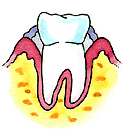
Gum Disease Treatments
Gum disease treatment is one of the most common dental treatments performed by dentists, along with dental fillings. Almost 90% of the population will need gum disease (periodontal disease) treatment some time in their life.
Importance of Gum Disease Treatment
With periodontal disease being the number one cause of tooth loss, gum disease treatments are extremely important for the preservation of teeth and maintaining good oral health and proper mouth functionality.
The increase of life expectancy and the focus on better quality of life has made the treatment of gum disease much more important than in previous generations. Having to wear dentures for several years because they had lost their teeth from periodontitis and tooth decay might have been expected for our grandfathers but no more in modern societies. Especially in our time when the advances in dentistry have to offer us several types of effective treatments for gum disease.
Problems caused by untreated gum disease
Gum disease is the result of bacterial infection of periodontal tissues. Several causes may lead to gum health problems, however the main cause of gum disease is considered the growth of dental plaque due to poor oral hygiene.
In the first stage of gum disease, called gingivitis, the infection causes inflammation of gingival tissues with only mild symptoms such as redness and tenderness of the gums. Gingivitis is a reversible form of gum disease that does not cause permanent damages. If the gum disease is not treated early, it progresses to the more severe form, periodontitis, that causes irreversible damages to periodontal tissues. Lack of proper gum disease treatment may cause a number of severe dental problems that include:
- Severe infection of the soft tissues around teeth (gum abscess - facial cellulitis)
- Severe infection of the jaw bones (osteomyelitis)
- Tooth abscess
- Loss of jaw bone mass
- Increased tooth mobility
- Tooth loss
- Trench mouth
Treatment Goals
When periodontal disease has been diagnosed, the main therapeutic goals of periodontal therapy / treatment are to:
- Reduce inflammation and
- Stop the progress of gum disease
- Eliminate the bacterial infection that causes gum disease, / and its etiology
- Identify and address any underlying causes or contributing systemic illnesses
- Prevent the recurrence of periodontitis / eliminate periodontal pockets to allow the patient to easily maintain good oral health
- Restore damage caused to soft or/and hard tissues (gums, periodontal ligaments and bone)
- Replace lost teeth, if it is too late to be saved.
What affects the type of gum disease treatment you need?
The treatment of gum disease is simple and easy in its early stages of mild gingivitis. For that reason, early symptoms of periodontal disease should not be ignored. You should visit your dentist for consultation immediately if you notice redness, tenderness or bleeding of the gums.
Regular dental visits every 6 months are also very important for the successful treatment of gum disease, because the dentist can identify signs of periodontal disease that may be still not be noticed by the patient. If gum disease is diagnosed, the type of treatment that will be recommended by the dentist depends on several factors:
- stage of periodontal disease – how far the disease has progressed
- extend of damage to periodontal tissues
- the number of affected teeth
- etiology of the disease
- overall health, medical history and age of the patient
- patient’s compliance in following dentist’s oral hygiene advise
- cost of gum disease treatments
- patient’s expectations and tolerance for specific medications or dental procedures
Types of periodontal disease treatments
The dentist or the periodontist can perform a series of different dental procedures for the treatment of gum disease depending on the progress of the damage in the tissues surrounding teeth. These can be categorized in:
Non-Surgical treatments of gum disease
Gum disease treatment procedures that do not include surgery are usually enough for the treatment of mild cases of gingivitis in the early stages of periodontal disease. They include:
- Oral hygiene
- Professional dental cleaning
- Tooth scaling and Root planing (SRP)
- Antimicrobial therapy
Surgical treatments of periodontal disease
In the advanced stages of periodontal disease, treatments that involve gum surgery are necessary to either restore some of the damage caused to periodontal tissues or to create a more maintainable periodontal environment to prevent the recurrence of the disease. They include:
- Gingivectomy / gingival curettage
- Pocket depth reduction / Flap surgery
- Soft tissue grafts
- Periodontal bone grafts
- Guided Tissue Regeneration
- Osseous surgery
- Dental implants
The 3 phases of a Gum Disease Treatment
The gum disease treatment process may be divided into 3 phases:
- The initial control phase - the aim is to control dental plaque, eliminate the bacterial infection and stop the progress of the disease. Any contributing factors are addressed and controlled, if possible.
- The corrective phase – corrective procedures are usually only required when the gum disease has advanced enough to cause damage to periodontal tissues. In some cases other dental treatments such as the orthodontic correction of malocclusion may be recommended as a preventive measure to prevent gum disease from recurring in the future.
- The maintenance phase – proper maintenance is necessary to reinforce oral hygiene to prevent recurrence of gum disease. This could include visiting the dentist for examination and possibly professional cleaning more often than the regular twice a year.

